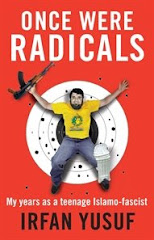
The following column was first published on the Webdiary while I was touring Indonesia for two weeks in January 2006.
I am sitting here in an internet cafe near the Hotel Ibis in Yogyakarta, Indonesia's major university town. Our delegation of five Aussie Muslims has just had a meeting with students and staff at the Centre for Religious and Cross-Cultural Studies at the Gadjah Mada University.
We are now entering the second week of our Indonesian escapade, a tour of young Muslims organised by the Australia Indonesia Institute. We are discovering how much awesome variety exists in this extraordinary country. I am writing these lines in a hurry, and apologise to readers in case this seems like a disorganised jumble of thoughts.
If Australians think they are an open, multicultural and pluralistic society, they should understand that our multiculturalism is child's play compared to the multiculturalism we witness in this, the world's largest Muslim country.
And Aussie Muslims in particular have plenty to learn. In this awesome and hauntingly beautiful land, Islam has adapted itself to a wide variety of cultural and linguistic settings.
In Jakarta, the capital of Indonesia you will find women sitting side by side with men in the largest mosque in South East Asia. The Masjid Istiqlal (Independence Mosque) has no separate entrance for men and women. Everyone worships in the same hall. There are no curtains. Women enter the mosque, regardless of how they are dressed.
Across the road from the mosque is the Catholic Cathedral of Jakarta. When parking in the Cathedral overflows for services, worshippers use the mosque carpark.
Today I met a Muslim Balinese student studying in “Jogja” (as Yogyakarta is often referred to by locals). He told us that in Bali, it is almost impossible to tell if a person is Muslim or Christian or Hindu from their name. He also spoke of how Balinese people of all faiths are suffering because of the drop in tourism since the Bali bombings. Many talented Balinese students are finding it impossible to study in universities as their families cannot afford the tertiary fees. Such students are forced to terminate their studies in Year 12.
I also met a Muslim girl from Java. She wears a “jilbab”, the word Indonesians use to describe a headscarf. I asked her name, and she told me she was called “Sita”. I was surprised because Sita is a name typically associated with Hinduism.
In India, one would rarely find a Muslim girl named Sita. But in Indonesia, people are proud of their Hindu heritage. Hindu names are still used even by the most observant Muslims. Tonight we will be seeing a traditional play using shadow puppets. The play tells the story of the Ramayana, an ancient Hindu epic.
Many people think Indonesian women are covered from head to toe. But anyone who sets foot on a Jakarta footpath will see young girls wearing hipster jeans and tank tops. The young guys are all dressed in jeans and t-shirts. Just like at the mosque, segregation is hardly anywhere to be seen.
We leave Jakarta on 29 November. Sadly, we will miss seeing Chinese New Year, now a public holiday in Indonesia. Things have changed since the Suharto era when Chinese culture was relatively suppressed and Chinese had to adopt Indonesian names to move up the social ladder. Today, Mandarin programs are show on free-to-air TV, and Chinese New Year is even celebrated in many mosques.
In my next installment, I will tell readers about the work of a heroic group of Muslim women trying to help women suffering from domestic violence. Like in most countries, the scourge of violence against women exists in Indonesia.
I'll write more soon. I have to go to the bathroom to attend to the results of eating too much chillied and spicy food!
Words © 2006-10 Irfan Yusuf









